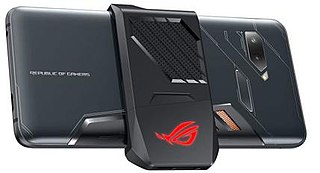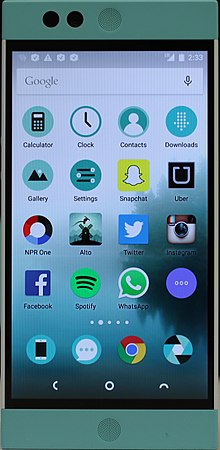Google Nexus is a discontinued line of consumer electronic devices that run the Android operating system. Google managed the design, development, marketing, and support of these devices, but some development and all manufacturing were carried out by partnering with original equipment manufacturers (OEMs). Alongside the main smartphone products, the line also included tablet computers and streaming media players; the Nexus started out in January 2010 and reached its end in October 2016, replaced by Google Pixel.
Micromax Informatics is an Indian multinational manufacturer of consumer electronics and home appliances, headquartered in Gurugram. It was established in March 2000 as an IT software company operating in embedded systems. It entered the mobile phone business in 2008 and, by 2010, became one of the largest companies making low-cost feature phones in India.

The Acer Iconia is a range of tablet computers from Acer Inc. of Taiwan.

Samsung Galaxy Ace 2 (GT-I8160) is a smartphone manufactured by Samsung that runs the Android operating system. Announced and released by Samsung in February 2012, the Galaxy Ace 2 is the successor to the Galaxy Ace Plus.

The Samsung Galaxy S series is a line of flagship Android smartphone and tablet computer produced by Samsung Electronics. In conjunction with the foldable Galaxy Z series, the lineup serves as Samsung's flagship smartphone lineup.

The Omate TrueSmart is a smartwatch designed by Omate, a Chinese company based in Hong Kong and Shenzhen. It has been funded by crowd funding via Kickstarter. The funding period was from August 21, 2013 until September 20, 2013. The funding goal of $100,000 was reached within 12 hours, with more than $1,032,000 raised by the end of the campaign. In contrast to other smartwatches, the Omate is a complete standalone telecom mobile device that can be used to make calls, navigate and use Android apps independent of the user's smartphone.

The Xiaomi Redmi 1 is a smartphone released in July 2013 in China And August 2013 in Global, developed by the Chinese smartphone company Xiaomi Inc. It is the first product of the Redmi series of smartphones. It came with a 4.7-inch 720x1080 IPS screen, a MediaTek MT6589T Quad-core 1.5 GHz Cortex-A7 processor and originally run Android 4.2.2 Jellybean with the MIUI v5 user interface, upgradeable to Android 4.4.2 Kitkat with the MIUI 9 user interface.

The Xiaomi Redmi 1S, code-named armani HM 1S, is a smartphone released in May 2014, developed by the Chinese company Xiaomi Inc. It is a part of the Redmi series of smartphones, and succeeded the Redmi 1. Visually similar to its predecessor, it comes with a 4.7-inch screen, a quad-core 1.6 GHz Cortex-A7 processor and runs Android version 4.3 (Jellybean), bundled with the proprietary MIUI v5 user interface, which can be upgraded to MIUI v9 based on Android 4.4.4 KTU84P.

The Samsung Galaxy Mega 2 is an Android smartphone/tablet computer hybrid manufactured by Samsung and is the successor to the Samsung Galaxy Mega. It was released in September 2014.

The third-generation Moto G is an Android smartphone developed by Lenovo's subsidiary Motorola Mobility, unveiled in India on July 28, 2015 and released the same day. The Moto G4 is its successor.

The Sony Xperia Z5 Premium is an Android smartphone produced by Sony. Part of the Sony Xperia Z series, the device, at that point known by the project code name "Satsuki", was unveiled along with the Sony Xperia Z5 and Xperia Z5 Compact during a press conference at IFA 2015 on September 2, 2015. The device was first released in Taiwan on November 5, 2015, and was the first smartphone with 4K resolution.

The HTC Desire 200 is a low-end Android smartphone released by HTC in 2013. It uses a 3.5-inch display and single-core 1 GHz processor. It was officially unveiled on 18 June 2013 on the website of HTC. Its Taiwan release price was NT$4990.

The Xiaomi Redmi Note 3 is a smartphone developed by Xiaomi Inc. as part of Xiaomi's low-end Redmi smartphone line. It has three variants:
Pine Store Limited, known by its trade name Pine64, is a Hong Kong-based organization that designs, manufactures, and sells single-board computers, notebook computers, a smartwatch, and smartphones. Its name was inspired by the mathematical constants pi and e with a reference to 64-bit computing power.

The Razer Phone is an Android-based phablet designed and developed by Razer Inc., released on November 15, 2017. While the device was designed mainly for mobile gamers, reviewers such as Engadget have noted that it is also good enough for everyday use.
Vivo V9 is an Android smartphone developed by Vivo Communication Technology Co. It was initially released in April 2018.The phone has 64 GB of internal storage and 4 GB of RAM. A microSD card can be inserted for up to an additional 256 GB. The phone has an Octa-core 2.2 GHz Cortex-A53 CPU and an Adreno 506 GPU.

The ROG Phone is an Android gaming smartphone made by Asus and the first generation of the ROG smartphone series. It was announced on June 8, 2018 at the Computex computer expo, being the first Asus smartphone to be targeted mainly to gamers. It competes with the Razer Phone, Xiaomi Black Shark, and ZTE Nubia Red Magic.

The Samsung Galaxy M31 is an Android smartphone manufactured by Samsung Electronics as part of the Galaxy M series. It was unveiled on 25 February 2020. Its key features include a 6.4 inch Super AMOLED display, a quad-camera setup and a 6000 mAh battery.
The Samsung Galaxy A12 is an Android smartphone manufactured by Samsung Electronics. The phone was announced in November 2020 as a successor to the Samsung Galaxy A11. The phone has a quad-camera setup with a 48 MP main camera and a 6.5 in (170 mm) HD+ Infinity-V display. The Li-Po battery has 5000 mAh. It shipped with Android 10, which can be updated to Android 12.
The Samsung Galaxy A03 is a series of budget Android smartphones manufactured by Samsung Electronics that includes the A03, A03s and A03 Core. They have a 6.5-inch FHD+ Infinity-V display, a 5000 mAh Li-Po battery, and ship with Android 11.














